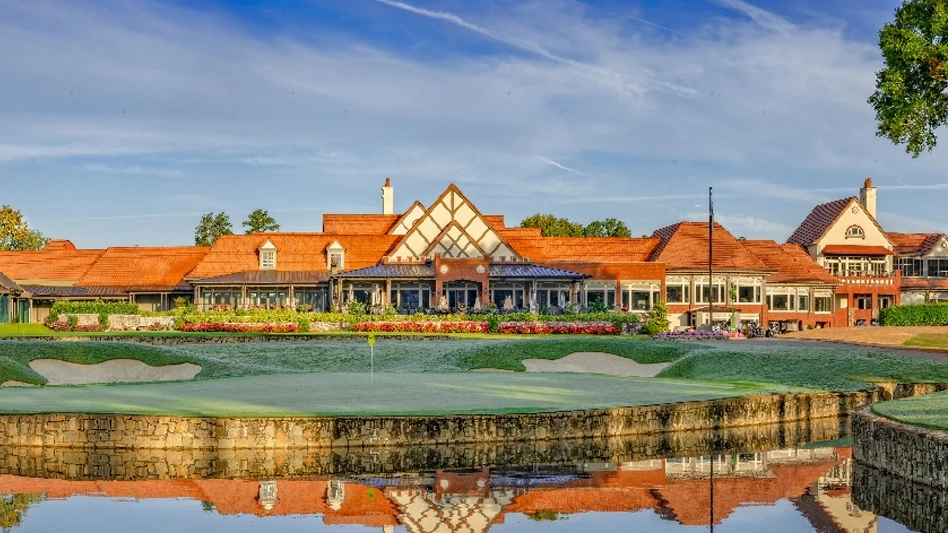

The literary genre of the club history is vastly underrated as a resource in golf. Maybe that’s because some of them are clunkers, filled with photos of weddings, swim teams and debutante balls and with scant reference to the golf course. But a lot of them are wonderfully done and help document aspects of design, course evolution and maintenance that would otherwise be lost.
I have been collecting them for decades and have noticed an uptick in their quality of late, in part due to the enhanced attention paid to such books as we enter the 100th anniversary of the Golden Age of Golf Course Architecture and thus are seeing many serious centenary volumes. These piggyback on the recent revival of classical design appreciation, evident in the course restoration movement.
A good part of Olympia Fields Country Club’s centennial volume, “Golf Under the Clock Tower” by Tim Cronin explores the complicated tale of how the country’s biggest private club went from 72 holes to 36 – and how the remaining North and South Courses have fared in terms of presentation and playability. Likewise, Jeff Neuman’s “Mountain Ridge Country Club: The First One Hundred Years” pays close attention to what are some of Donald Ross’ most elegant greens and how they fared in the hands of Ron Prichard’s restoration. Kudos to Neuman for also presenting detailed material on the club’s famed Tudor-style clubhouse and its legendary architect, Clifford Charles Wendehack.
Superintendents at clubs contemplating a club history can help the process along by opening their files and encouraging the book committee to do a serious deep dive. It helps hiring a qualified researcher/writer for the job rather than leaving it up to some amateur committee person who might have an interest.
Clubs should be prepared to spend some money if they are interested in getting anything of quality. Having written three such books and now at work on a fourth, I can assure you that the budget needs to be reasonable in allowing room not simply for research and writing but also for design of the pages, quality color photography and printing. It also makes a big difference how many copies are printed, with unit costs going down the more you print. Most clubs print between 1,000 and 2,000. Fewer than that and your unit costs are high. More than that and you should be prepared to have them boxed in the basement for a while.
Budgets can range dramatically, from $35,000 at the low end to as much as $200,000 for a high-quality hardback that involves aerial imagery and extensive reproduction of vintage posters. Clubs should not expect to make money on the project but can recoup upwards of half their costs through pricing the volume appropriately. It’s best to think of a club history as a glorified branding device, an oversized business card for publicizing the club’s reputation. Along the way you instill a sense of pride among the membership that you have something valuable to document.
Having a famous architect’s name on the course makes telling the story easier because you can always include biographical narrative that brings to life that designer’s overall work. It helps if the club has hosted major events or state championships. But it’s also possible to use visits by great golfers as material for vignettes. I also think it worthwhile to highlight the service of distinguished employees – not just golf pros, club managers and superintendents but also caddies and wait staff.
Members who think of themselves handy with a camera prove no match for experienced photographers who know how to create interesting imagery. Drone photography is a great tool but can be overdone if you ignore the perspective that golfers actually see. Sometimes oddball shots can also convey a lot. Among my favorites are photos from the maintenance area showing off equipment or the mechanics boneyard. In a book about a Devereux Emmet-designed course on Long Island, “St. George’s Golf & Country Club, 1917-2017,” I was able to show the openness of the place and its shared fairways through a closeup of a single sprinkler head displaying the yardage to two greens, 173 to the second and 169 to the 18th.
Club histories don’t have to be dull recitations of land lease arrangements or who won the 1953 club championship. They can explore the natural history and geology of the place as well as the culture of the membership. They are best thought of as a marketing tool to showcase what makes the place special.

Explore the September 2021 Issue
Check out more from this issue and find your next story to read.
Latest from Golf Course Industry
- AQUA-AID Solutions bolsters Sunshine State presence
- Escalante Golf acquires secluded Illinois course
- Tartan Talks 105: Nathan Crace and Todd Quitno
- Disease Discussion 24: Let the turf talk to you
- From the publisher’s pen: Foggy intrigue
- USGA releases Water Conservation Playbook
- Vilamoura Golf courses awarded GEO Certified status
- GCSAA’s Health in Action 5K/2K reaches fundraising goal





